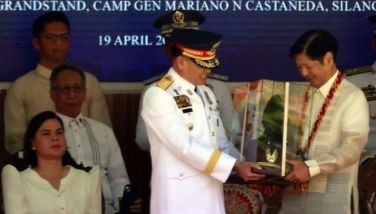Long wait ends for HR victims
MANILA, Philippines - Labor leader Romy Castillo will never forget the events of July 23, 1984, the day he was introduced to wet submarine, dry submarine and electrocution.
Following his arrest by agents of the Marcos regime, Castillo was subjected to nine days of torture and abuse meant to break his will and make him admit his affiliation with the communists.
His ordeal finally ended on Feb. 26, 1986, the day after the people power revolt booted Marcos out of Malacañang.
President Aquino is set to sign into law today an act recognizing the atrocities of the Marcos government and granting reparation to human rights victims like Castillo.
Castillo, now 61, recalled that around 2 a.m. of July 23, 1984, agents of the Metrocom Intelligence and Security Group (MISG) raided the staff house of the labor group Kilusang Mayo Uno (KMU) in Barrio Tubigan, Antipolo, and arrested him and four of his fellow labor leaders. He was beaten until he lost consciousness.
Castillo, also known as Ka Romy, said they were planning to stage a big rally of workers against Marcos.
Tagged as the “Antipolo 5,†the arrested activists were taken to a safehouse in Bicutan, Taguig where they were forced to admit their affiliation with the communists. When they refused, they were subjected to various forms of torture that almost cost them their lives.
Castillo welcomed the news of Aquino signing into law the Human Rights Victims Reparation and Recognition Act of 2013, as part of today’s commemoration of the 27 anniversary of the people power revolt.
The legislation is official recognition by the government of the Marcos regime’s atrocities, including summary executions, torture and forced disappearances of people suspected of affiliation with the underground movement.
The law will also grant reparation for human rights victims of Martial Law and will create the Human Rights Violations Victims’ Memorial Commission, which will work with the Department of Education (DepEd) and Commission on Higher Education (CHED) for the teaching in schools of the abuses inflicted on opponents of the Marcos dictatorship.
Castillo said he and the other victims of the Martial Law have long been waiting for reparation and recognition, and sees this as a political victory for them.
“Finally, after a long delay, there will be recognition and reparation for the victims of the Marcos dictatorship. This is so beautiful… the recognition will serve as lesson that it will never happen again. This is the most significant part here,†he said.
“At first I did not believe the Marcos ill-gotten wealth could be recovered and be paid to the victims. This proves that this is possible. This is really a milestone,†he added.
After his release from prison in 1986 following the downfall of the Marcos dictatorship, Castillo returned to trade union organizing work. But he can not forget the events that transpired in the wee hours of July 23.
“Five of us were taken. That’s why we were called ‘Antipolo 5’.†With him were three other men – also fellow trade union leaders – and a woman, a sympathizer who owned the house.
“I am classified as a missing-resurfaced-alive person,†he said, explaining that other political prisoners and those arrested during the Martial Law years were classified as “missing-resurfaced-dead,†or simply “still missing.â€
He said the five of them were kept in separate rooms, constantly tortured by their captors, who made sure the screams of one would be heard by the others.
“It was psychological warfare. But, it was alright, at least I would know one of my companions is still alive because I could hear his screams.†he said
He said of the four torture methods – wet submarine, dry submarine, psychological torture and electrocution – that he was subjected to, it was the latter that he dreaded the most.
A “wet submarine,†Castillo explained, was a trip to the latrine where his head would be pushed down into a commode filled with feces.
“Dry submarine†involved suffocating him with a plastic bag until he passed out.
He said he knew it would be electrocution if his captors made him sit on a sack on the floor and poured water on him.
Minutes later, he would hear the whirl of a hand-cranked dynamo, and he would feel hands attaching wires to his feet.
“It’s so painful. My whole body would shake, particularly when the electricity would reach my neck and head. It felt like my brain and eyes would burst out of my skull,†he recalled.
Shaking in pain, Castillo said his captors would make fun of him by drowning his screams with loud speakers placed inside the room, blaring Neil Sedaka’s song “My World is Getting Smaller Everyday.â€
For nine straight days at the safe house, Castillo was stripped naked, handcuffed, chained, blindfolded, and made to sleep on the cold concrete floor.
The blindfold and handcuffs would only be removed when he would be allowed to eat. There was no way of knowing day from night, or what the date was.
The torture was meant to force them to admit their links with the communists.
“They were asking who administered my oath, who were the communist elements around me, how many of us took the oath, or where we held the oathtaking,†he said. He refused to answer any of their questions.
Several times, his captors, who wore bonnets to conceal their identities, would threaten to pick up his girlfriend and have her gang-raped.
“But I knew it was just psychological torture, because at one point during interrogation, they asked me the name of my girlfriend. I told them, ‘You’re saying you’ll have her gang-raped, and yet you don’t know her’.â€
That retort earned him more beatings.
The most traumatic torture he was subjected to involved a homosexual captor, who fondled his genitals with baby oil. The torturer got mad when he did not get an erection, and poked his penis with a barbecue stick.
He developed an infection, which infuriated then MISG commander Rolando Abadilla, who came for a visit, and ordered him sent to the Camp Panopio military hospital in Cubao, Quezon City for treatment.
“Kabise (their name for Abadilla) was angry when he saw me shivering on the floor due to infection,†he said.
While recuperating at the hospital for 15 days, Castillo was chained to his bed and placed under guard.
When he recovered, he was sent back to the safe house, where he found his captors have become lenient. He was no longer blindfolded, was allowed to wear an old pair of shorts, and walk outside the safe house.
It was only then that he realized the safe house was inside Camp Bagong Diwa, near the dormitories of drug addicts undergoing rehabilitation.
The labor leader said he only managed to reach Grade 4. He spent his early years working as a sakada in the sugarcane plantations in La Carlota City, Negros Occidental.
In 1966, when he was just 15, he stowed away on a boat to Manila and lived with an aunt who offered to send him to school. He refused, and chose to work, taking on odd jobs until he landed at a steel mill in Pasig.
It was at the steel mill that Castillo discovered his knack for organizing his fellow workers. Soon he became their union leader under the militant KMU, eventually becoming KMU’s Area 2 chairman for the Port Area of Manila and Eastern Rizal, until the day the MISG raided their staff house.
“I’m a thoroughbred laborer. I worked at the Philippine Blooming Mills in Rosario, Pasig. I started there in 1976, and I was the acting union president,†he said.
When they were inquested in Rizal fon rebellion charges, Castillo pleaded with the fiscal, a certain Colonel Alsaga of the Judge Advocate General’s Office (JAGO), to transfer him and his fellow Antipolo 5 detainees to a regular detention facility.
Their counsel was then MABINI (Movement of Attorneys for Brotherhood, Integrity and Nationalism, Inc.) lawyer and now Vice President Jejomar Binay
“We told the court that our whereabouts are being concealed from our families.â€
He said Binay managed to convince Alsaga to order their transfer to a regular detention facility. But the MISG refused.
“Although we were already brought in for inquest, they still kept on hiding us. We went missing for 60 days. It was the end of September that we were transferred to a regular detention center inside Bicutan,†he said.
Castillo believed their transfer to a regular detention facility was the result of the pressure exerted by cause-oriented groups on the military, including Amnesty International, which one Christmas day sent him 150 Christmas cards written by schoolchildren from England, Japan and Latin America.
“We were always in the newspaper headlines. Our colleagues were looking for us in camps, morgues, and hospitals.â€
At the regular detention facility, Castillo said they had a more relaxed time and had the chance to meet fellow known “nat-dem†(national democrat) activists like Satur Ocampo, Fidel Agcaoili and Alan Jasminez.
The guards allowed family members and girlfriends to visit.
Castillo said his girlfriend was even given a special pass to visit him by then Defense Minister Juan Ponce Enrile.
“My family was in Negros, so the only one who visits me was my girlfriend. She’s a tibak (activist) at the St. Joseph College whom I met during their immersion. I told her, she’s my type, and that I liked to take her along with me to the street. She went along,†he said.
After his release in 1986, Castillo married then 23-year old Maritess Angeles. They have two children, Raiza, 23, who finished Food Technology at the University of the Philippines in Los Baños, and 20-year-old Riel who is finishing his Architecture course at UP Diliman.
Maritess died last December.
“No one among my children became an activist. They said they didn’t like a revolutionary life,†he said with a smile.
The end of his ordeal began on the evening of Feb. 26, 1986.
They watched on television as Enrile and then Philippine Contabulary chief Fidel Ramos withdrew support from Marcos, and an uprising was ongoing.
Upon hearing the news, Castillo and other detainees, including Jasminez and activist Gerry Bulatao, went to negotiate with their jail warden, a certain Colonel Uliquino, that they be released as the camp would most likely be attacked by government forces.
“I told him the UN states that when a country is at war, all political prisoners should be freed.â€
Castillo said Uliquino assured them that at the first volley of gunfire, all political prisoners would be released.
“We were 26 nat dems at the second floor and 35 from the soc-dems (social democrats), Light A Fire Movement and the April 6 Liberation Movement on the apartment’s ground floor. We requested that we also get arms as the camp is undermanned and that we could defend the camp together,†he said. Uliquino refused his request.
On the afternoon of Feb. 26, 1986, the jail warden instructed the Antipolo 5 and six other soc-dem detainees to get dressed.
Castillo recalled asking the warden if they were to bring clothes, thinking they would be transferred to another jail. The warden told them to just wear ordinary clothes.
Shortly after, the detainees were loaded on two military jeeps and heading towards Camp Crame in Quezon City when one of the vehicles had a flat tire near EDSA.
Castillo would later learn from their escorts that they were supposed to be presented to foreign media as released political prisoners after a thanksgiving Mass at Crame.
As the group missed the Mass and arrived late at the gates of Crame, they were “ambushed†by the foreign press.
“They asked me: ‘Are you happy with your release?’ I answered: ‘Yes of course. I am happy now that I can take 100 steps forward when before I could only take seven steps’,†he said.
- Latest
- Trending



























